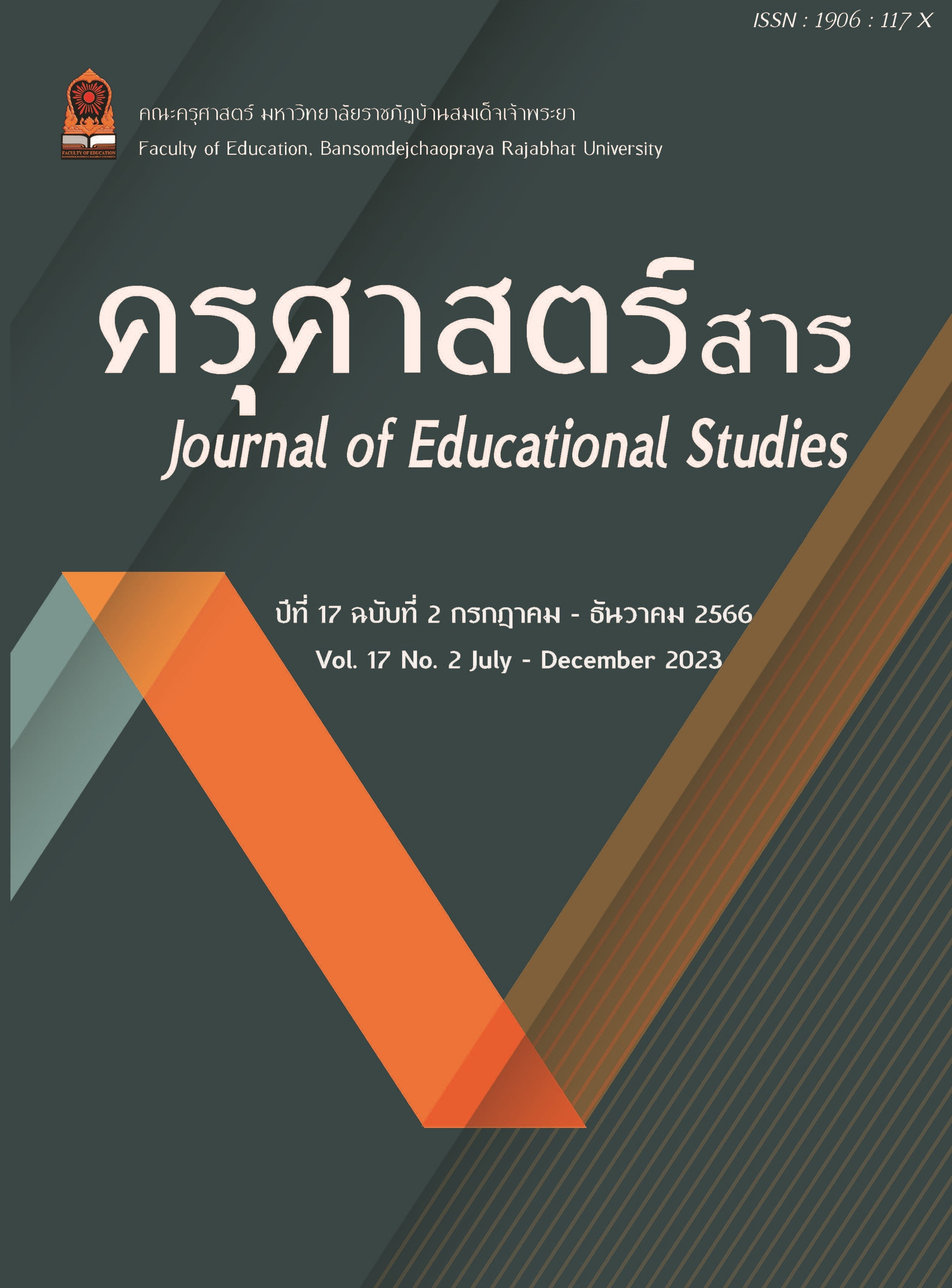The Development of English Speaking and Listening skills of Grade 3 students through Blended Active learning
Keywords:
The Development of English Speaking and Listening skills, Student, Blended Active learningAbstract
This research aimed to 1) develop English listening and speaking skills of Grade 3 students by using blended active learning activities. 2) study the student’s satisfaction by using blended active learning activities. The target group comprised 31 third-grade students of Anubanbanglamung School. Banglamung District, Chonburi Province, Chonburi Office of Primary Education Service Area, in the 1stsemester of academic year 2022, obtained through cluster random sampling, The research instruments consisted of a lesson plan. 2. Listening and Speaking test, pre-test, and post-test 1 set 3. Multimedia 4. A satisfaction questionnaire. The statistics used in data analysis were t-test, z-score, percentage and mean.
The research findings were as follow:
1) The results of the development of English speaking and listening skills of Grade 3 students through blended active learning revealed that the students' learning achievement was higher than before the study. Make sure that successes follow expectations.
2) The students were satisfied with learning by using blended active learning activities at the highest level. The student had the highest level of satisfaction in the three ranks. Students have more courage to speak English. Blended active learning activities make the students have fun. Students can converse in simple English sentences. The lowest level of satisfaction in the three ranks. Blended active learning activities promote interaction between teachers and students, respectively. Students can communicate with foreigners. Blended active learning activities It gives students more experience learning English.
Downloads
References
จารุพร ตั้งพัฒนกิจ. (2563). วารสารบริหารธุรกิจและศิลปศาสตร์. เชียงใหม่ : ราชมงคลล้านนา
ชายุดา จันทะปิดตา. (2555). การพัฒนาทักษะการฟังภาษาอังกฤษเพื่อการสื่อสาร สำหรับนักเรียนชั้นมัธยมศึกษาปีที่ 4 โรงเรียนบัวหลวงวิทยาคม : บุรีรัมย์.
ไชยยศ เรืองสุวรรณ. (2553). Active Learning. ข่าวสารวิชาการ. เชียงใหม่ : มหาวิทยาลัยเชียงใหม่.
ทัศนีย์ ทองศร. (2558). การพัฒนาทักษะการพูดภาษาอังกฤษของนักเรียนชั้นมัธยมศึกษาปีที่ 5 โดยใช้บทบาทสมมติ. สาขาวิชาภาษาอังกฤษ. สูตรปริญญาศิลปศาสตรมหาบัณฑิต มหาวิทยาลัยนเรศวร.
ธีราภรณ์ กิจจารักษ์. (2553). ปัจจัยที่มผลต่อการพูดภาษาอังกฤษของนักศึกษาชั้นปีที่ 2. สาขาวิชาภาษาอังกฤษ คณะครุศาสตร์ มหาวิทยาลัยราชภัฏในเขตกรุงเทพมหานคร. กรุงเทพ: มหาวิทยาลัยราชภัฏสวนสุนันทา.
ณัชนัน แก้วชัยเจริญกิจ. (2550). ภาวะผู้นำและนวัตกรรมทางการศึกษา: บทบาทของครูกับ Active Learning. สืบค้นจาก http://www.pochanukul.com ข้อมูลเมื่อวันที่ 20 มกราคม 2560.
นนทลี พรธาดาวิทย์. (2559). การจัดการเรียนรู้แบบ Active learning (พิมพ์ครั้งที่ 2). กรุงเทพฯ: ทริปเพิ้ล เอ็ดดูเคชั่น.
พุฒินาท ปัตฐานัง. (2560). การพัฒนาทักษะการอ่านภาษาอังกฤษโดยใช้วิธีการเรียนรู้แบบสะกดคำประกอบการเรียนรู้แบบ. มหาวิทยาลัยสารคาม.
พรสวรรค์ สีป้อ. (2550). สุดยอดวิธีสอนภาษาอังกฤษ นำไปสู่การจัดการเรียนรู้ของครูยุคใหม่. กรุงเทพฯ: อักษรเจริญทัศน์.กลุ่มร่วมมือเทคนิค TAI การเรียนรู้ภาษาอังกฤษด้วยเทคโนโลยีที่ทันสมัย
มยุรา วิริยเวช. (2559). บทบาทของผู้ปกครองคนไทยในการส่งเสริมทักษะการฟังและการพูดภาษาอังกฤษสำหรับเด็กปฐมวัย: กรณีศึกษา ในโรงเรียนนานาชาติในประเทศไทย. กรุงเทพฯ : มหาวิทยาลัยธรรมศาสตร์.
ฤทัยรัตน์ ศรีพวงมาลัย (2561) การพัฒนาผลสัมฤทธิ์ด้านการฟังภาษาอังกฤษเพื่อความเข้าใจโดยการจัดการเรียนรู้ผ่านพอดคาสต์ ของนักเรียนชั้นประถมศึกษาปีที่ 6 โรงเรียนหนองกุงศาลาน้้าเที่ยงวิทยากร.กรุงเทพ: มหาวิทยาลัยศิลปกร
วาสนา สิงห์ทองลา. (2555). การพัฒนาทักษะการฟังภาษาอังกฤษของนักเรียนชั้นประถมศึกษาปีที่ 5 โดยใช้รูปแบบการจัดการเรียนรู้ภาษาเพื่อการสื่อสาร. วารสารศึกษาศาสตร์. มหาวิทยาลัยขอนแก่น.
Jordan, M. (2007). What a podcast is - and everything you need to know about podcasting. Retrieved from http://www.americanchronicle.com/articles/viewArticle.asp?articleID=47099
Krashen, Stephen D. and Terrell, Tracy D. (1983). The Natural approach. Oxford : Pergamon Press.
Garnham, C., & Kaleta, R. (2002). Introduction to hybrid courses. Teaching with Technology Today, 8(6). Retrieved May 5, 2015, from http://www.uwsa.edu/ttt/articles/garnham.htm
Downloads
Published
How to Cite
Issue
Section
License

This work is licensed under a Creative Commons Attribution-NonCommercial-NoDerivatives 4.0 International License.
บทความที่ได้รับการตีพิมพ์เป็นลิขสิทธิ์ของคณะครุศาสตร์ มหาวิทยาลัยราชภัฏบ้านสมเด็จเจ้าพระยา
ข้อความที่ปรากฏในบทความแต่ละเรื่องในวารสารวิชาการเล่มนี้เป็นความคิดเห็นส่วนตัวของผู้เขียนแต่ละท่านไม่เกี่ยวข้องกับมหาวิทยาลัยราชภัฏบ้านสมเด็จเจ้าพระยา และคณาจารย์ท่านอื่นๆในมหาวิทยาลัยฯ แต่อย่างใด ความรับผิดชอบองค์ประกอบทั้งหมดของบทความแต่ละเรื่องเป็นของผู้เขียนแต่ละท่าน หากมีความผิดพลาดใดๆ ผู้เขียนแต่ละท่านจะรับผิดชอบบทความของตนเอง


